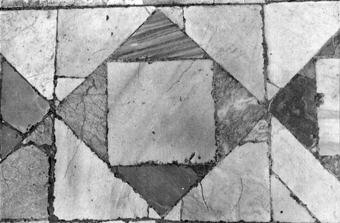
|
The Square and the Roman House: Architecture and Decoration at Pompeii and Herculaneum |
|---|
Kansas State University, Manhattan, Kansas, USA
 The
domus is the ancient Roman single-family urban
house type, best known from the excavations at Pompeii and Herculaneum.
Analysis of a number of houses at these sites suggests that two
simple geometric systems, both based on the square underlie the
design of the Roman house at all scales. One of these is the
ad quadratum, or square root of 2 progression.
A related system is known as the "sacred cut." The
only surviving written treatise by a Roman architect, that of
Vitruvius, does not specifically discuss the geometric systems
to which I refer, but does mention several times the importance
of geometry to the architect.
The
domus is the ancient Roman single-family urban
house type, best known from the excavations at Pompeii and Herculaneum.
Analysis of a number of houses at these sites suggests that two
simple geometric systems, both based on the square underlie the
design of the Roman house at all scales. One of these is the
ad quadratum, or square root of 2 progression.
A related system is known as the "sacred cut." The
only surviving written treatise by a Roman architect, that of
Vitruvius, does not specifically discuss the geometric systems
to which I refer, but does mention several times the importance
of geometry to the architect.
These geometric systems explain the proportional relationships which are found in the overall shape of the house site and its organization and subdivision. The dame geometry and dimensions based on the "regulating square" of the house as a whole appears to determine the proportions of volumes of space throughout the house. These systems apply to the composition of the wall painting and pavement patterns within the rooms as well.
The house was of great importance to the Romans. The domus was one of their earliest building types and remained the archetype for other buildings. As such, it embodies the basic characteristics of Roman design, including an emphasis on a center. Both ad quadratum and the sacred cut are systems which emphasize a center through concentric reiterations of the same geometric operation. The emphasis on center is important in the domus at a variety of scales, for example in the central atrium space, centered wall painting compositions, or central floor mosaics. The Roman world view, placing themselves in the center of the universe, permeates their design at all scales, including the organization of the empire, the layout of cities, and the design of most building types As a basis for the conception and construction of the domus, the square thus serve a symbolic as well as pragmatic role.
|
Carol Martin Watts, "The Square and the Roman House:Architecture and Decoration at Pompeii and Herculaneum", pp. 165-181 in Nexus: Architecture and Mathematics, ed. Kim Williams, Fucecchio (Florence): Edizioni dell'Erba, 1996. http://www.nexusjournal.com/conferences/N1996-WattsC.html |
|
|
|
|
